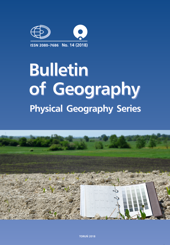The internet as a source of knowledge about soil cover of Poland
DOI:
https://doi.org/10.2478/bgeo-2018-0009Keywords
Internet, soils, university education,Abstract
The aim of this paper is to assess the quality and correctness of information on Polish soils available on selected websites. Particular attention was paid to educational portals, which became the subject of evaluation of the information its contains in terms of the correctness, up-to-dateness and reliability.
Twenty-five websites representing educational portals and blogs were selected for analysis in terms of their contents (type of subject matter) correctness (substantial value), curentness (presence of up-to-date information) and completeness.
Most of the information on the evaluated educational portals is targeted at high school students. These websites present only basic content. The most frequent issues on the analyzed portals were: soil types and soil systematics, distribution of soils in Poland, definition of soil and also soil valuation classes. Websites addressed to university students constitute a decided minority, could be said, that even an exception. One of those is article on Wikipedia, which has the highest educational value among all analysed websites.
References
Bednarek R., Świtoniak M., Mendyk Ł., 2015, Soil Types and Subtypes circa 1:700 000. [in:] Kozieł Z. (ed.) Atlas of the Kuyavian-Pomeranian Voivodeship, Toruń, Nicolaus Copernicus University Press: 54-55.
Brox H., 2016, Troublesome tools: How can Wikipedia editing enhance student teachers’ digital skills? Acta Didactica Norge 10, 2: 329 – 346.
Dogruer N., Eyyam R., Menevis I., 2011, The use of the internet for educational purposes. Procedia - Social and Behavioral Sciences 28: 606 – 611.
Jančařík A., Jančaříková K., 2010, Wiki Tools in the Preparation and Support of e-Learning Courses. Electronic Journal of e-Learning Volume 8 Issue 2 2010:123 – 132.
Marks N., Jakubowski T., Nawara P. 2012. Internet jako źródło pozyskiwania wiedzy potrzebnej do prowadzenia gospodarstwa rolnego. Inżynieria rolnicza, 2 (136), 1: 195-204.
Mocek A., 2014. Soil Science. PWN, Warsaw (in Polish).
Park, H. W., Biddix, J. P., 2008. Digital media education for Korean youth. International Information & Library Review 40(2): 104–111.
Sojka T., Charzyński P., Świtoniak M., 2018, Multimedia in Soil Science Education. [in:] Hibszer A., Szkurłat E., (eds.) Works of Geographical Education Commission, Polish Geographical Society, Volume 8 (in Polish) – in press.
Polish Soil Classification (Systematyka Gleb Polski), 1989, Roczniki Gleboznawcze – Soil Science Annual 40(3/4): 1–150 (in Polish with English summary).
Polish Soil Classification (Systematyka Gleb Polski), 2011, Roczniki Gleboznawcze – Soil Science Annual 62(3): 1–193 (in Polish with English summary).
Szpunar M., 2007. Internet - medium of information and disinformation. E-mentor 2(19): 46-51.
Welsch W., 1997, Artificial Paradises? Considering the World of Electronic Media - and Other Worlds. [in:] Welsch W. Undoing Aesthetics, Sage, London: 168-190.
https://www.eactive.pl/pozycjonowanie-stron/jakie-sa-najpopularniejsze-wyszukiwarki-internetowe-w-polsce-i-na-swiecie/ (accessed 23.04.2018)
http://www.macmoney.pl/statystyki-internetu-czyli-globalna-siec-w-liczbach/ (accessed 23.04.2018)
http://atlas.kujawsko-pomorskie.pl/ (accessed: 13.03.2018)
www.soils.umk.pl (accessed: 07.04.2018)
Downloads
Published
How to Cite
Issue
Section
License
Copyright (c) 2018 Bulletin of Geography. Physical Geography Series

This work is licensed under a Creative Commons Attribution-NoDerivatives 4.0 International License.
Stats
Number of views and downloads: 356
Number of citations: 0



